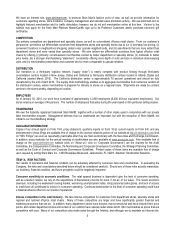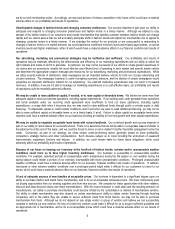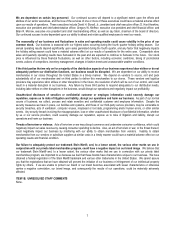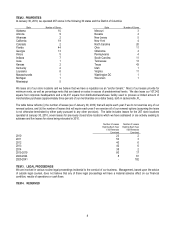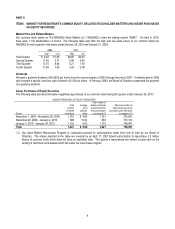Stein Mart 2009 Annual Report Download - page 17
Download and view the complete annual report
Please find page 17 of the 2009 Stein Mart annual report below. You can navigate through the pages in the report by either clicking on the pages listed below, or by using the keyword search tool below to find specific information within the annual report.and plan to carry a valuation allowance until such time that positive evidence is sufficient to justify realization. The 2009 ETR was
lower than the federal statutory rate of 35.0 percent due to the effect of certain book/tax differences on the valuation allowance
including a tax accounting method change made in the third quarter of 2009.
Year Ended January 31, 2009 Compared to Year Ended February 2, 2008
Net sales for the year ended January 31, 2009 were $1,326.5 million, down 9.0 percent from $1,457.6 million for the prior year. The
$131.2 million decrease reflects a $152.2 million decrease in the comparable store group and a $16.2 million decrease in the closed
store group, offset by a $37.2 million increase in the non-comparable store group due to the inclusion of sales for the 14 stores
opened in 2007 and the six stores opened in 2008. The closed store group includes the ten stores closed in 2008 and the two stores
closed in 2007. Comparable stores sales for 2008 decreased 10.9 percent compared to 2007.
Gross profit for year ended January 31, 2009 was $294.2 million or 22.2 percent of net sales compared to $361.4 million or 24.8
percent of net sales for 2007. The $67.2 million decrease in gross profit reflects a $64.9 million decrease in the comparable store
group and a $4.4 million decrease in the closed store group, partially offset by a $2.1 million increase in the non-comparable store
group due to the inclusion of operating results for the 14 stores opened in 2007 and the six stores opened in 2008. Gross profit as a
percent of sales decreased during fiscal 2008 due to a 1.1 percentage point increase in markdowns and a 2.0 percentage point
increase in buying and occupancy costs, offset by a 0.5 percentage point increase in markup.
SG&A expenses were $394.8 million or 29.8 percent of net sales for the year ended January 31, 2009 as compared to $388.6 million
or 26.7 percent of net sales for 2007. SG&A expenses for 2008 include $25.4 million of primarily non-cash pre-tax asset impairment
and store closing charges compared to $5.2 million in 2007. Asset impairment charges were $16.7 million higher in 2008 due to a
greater number of stores with projected cash flows that do not support the carrying value of their long-lived assets. Store closing
charges increased $3.5 million over last year because ten stores were closed in 2008 compared to only two store closings in 2007.
Excluding asset impairment and store closing charges, SG&A expenses were $369.3 million or 27.8 percent of sales in 2008
compared to $383.4 million or 26.3 percent of sales in 2007. This $14.1 million decrease in SG&A expenses resulted primarily from
significant reductions in advertising and store operating expenses, somewhat offset by professional fees related to expense reduction
initiatives. Advertising expenses decreased $15.2 million in 2008 due primarily to reduced broadcast media. Store operating
expenses decreased $8.2 million for the comparable store group due to cost saving initiatives and decreased $3.4 million for the
closed store group, but were offset by an $8.9 million increase for the non-comparable store group due to the inclusion of operating
results for the 14 stores opened in 2007 and the six stores opened in 2008. Corporate SG&A expenses were higher in 2008 primarily
due to professional fees related to ongoing expense reduction initiatives and higher benefit costs, while last year included $1.8 million
of separation costs for the resignation of the former President/Chief Executive Officer. SG&A expenses as a percentage of net sales
were higher this year due to a lack of leverage on lower sales.
Pre-opening expenses for the six stores opened in 2008 and the 14 stores opened in 2007 amounted to $1.5 million and $2.7 million,
respectively.
Other income, net decreased $1.0 million in 2008 compared to 2007 due to decreases in credit card income and shoe department
income, both resulting from the decreased net sales.
Interest expense, net increased $1.0 million during 2008 compared to 2007 due to higher borrowings at lower interest rates this year
compared to last year. During the third quarter of 2008, we borrowed an additional $75 million on our revolving credit agreement
which increased our notes payable to banks balance to $100 million. We maintained that notes payable balance through January 31,
2009, investing excess borrowings in short-term money market funds. Subsequent to year end, we liquidated these money market
funds and repaid that portion of its borrowings.
The effective income tax benefit decreased from 31.2 percent in 2007 to 12.9 percent in 2008 primarily due to recording a $19.0
million valuation allowance for deferred tax assets during the fourth quarter of 2008. ASC Topic 740, Income Taxes, requires that
companies assess whether valuation allowances should be established against their deferred tax assets based on consideration of all
available evidence using a "more likely than not" standard. In making such assessments, significant weight is to be given to evidence
that can be objectively verified. A company's current or previous losses are given more weight than its future outlook, and although we
were profitable in 2006 and posted a small loss in 2007, the results in 2008 produced a cumulative three-year loss, which is
considered a significant factor that is difficult to overcome. Accordingly, we established a deferred tax asset valuation allowance of
$19.0 million through a charge to tax expense.
Liquidity and Capital Resources
Our primary source of liquidity is the sale of merchandise inventories. Capital requirements and working capital needs are funded
15


